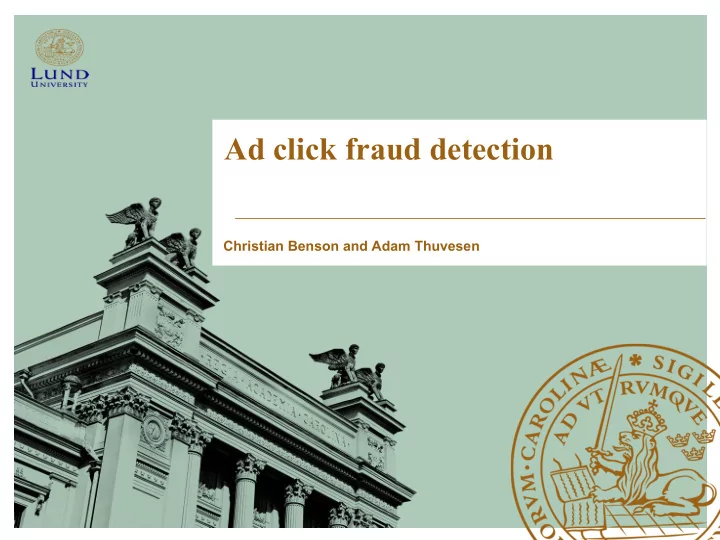

Ad click fraud detection Christian Benson and Adam Thuvesen
Problem ● Ad click fraud ○ Mobile ● Click fraud is a major issue for advertisers ○ Pay per click ads ■ The app creator (publisher) will profit from more clicks ○ Fraudulent automated clicks ■ The advertiser loses
Problem ● How to detect a fraudulent click in a mobile app? ○ Using data from ad clicks
Dataset ● Dataset from Kaggle ● 7 features ○ ip (ip address) ○ app (mobile app) ○ device (type of device) ○ os (operating system) ○ channel (channel id of mobile ad publisher) ○ click time (ad was clicked) ○ attributed time (time of possible download) ○ is attributed (ad led to app download or not)
Dataset ● 187M entries ● Very unbalanced ○ 99.8 % negative samples (not downloaded)
Baseline ● Dummy ● k-NN ● SVM ● Logistic Regression ● Decision Trees ● Random Forest ● Metric ○ ROC-AUC
Architecture Download: 0.01 Raw features Model Training Prediction Not download: 0.99 Training data Test data ● Raw data is used to train model ● Using trained model to predict on test set
Idea ● Decision trees performed well ● Research in the area supported various ensemble of decision trees to be successful in similar problems ● Data preprocessing - extract new features ● Gradient boosted trees ○ Frameworks ■ XGB popular ■ Microsofts LGBM newly gaining attention ● Neural net
How it works - Decision Trees Ensemble of Decision Trees
How it works - Gradient Boosted Trees Gradient Boosted Trees ● Error = bias + variance
Data preprocessing ● Data preprocessing - extract new features ○ Unique occurrences ○ Total count ○ Cumulative count ○ Variance ○ Mean ○ Aggregation ○ Previous/next click ○ Time ● 23-30 features in total
Training ● Trained on 10M entries ● Models ○ Neural net with embedding layer ○ LGBM ○ XGB
Solution ● Feature Engineering ○ Create new features from existing ones ● Gradient Boosted Trees ○ XGB ○ LGBM ● Ensemble of LGBM and XGB models ● Neural net not performing quite as well
Ensemble ● Combining two or more models for better results ● Can be done in several ways ● Logarithmic average
Solution architecture LGBM model LGBM 1 training Prediction LGBM model LGBM 2 training Prediction Feature Ensemble Raw data engineering prediction XGB model 1 XGB training Prediction XGB model 2 XGB training Prediction Training data Test data
Results ● LGBM best model: 0.9784 ● XGB best model: 0.9733 ● Neural net best model: 0.9508 ● Logarithmic ensemble mix including the two best LGBM and the two best XGB: 0.9787
Thank you for listening!
Recommend
More recommend